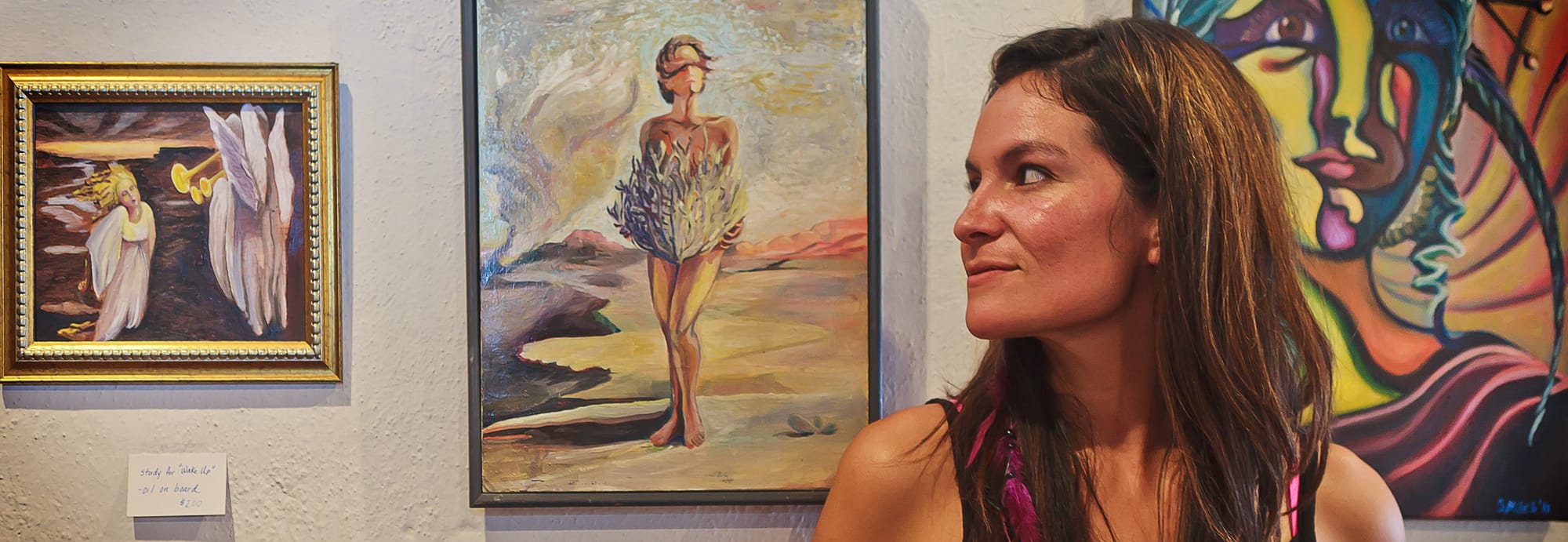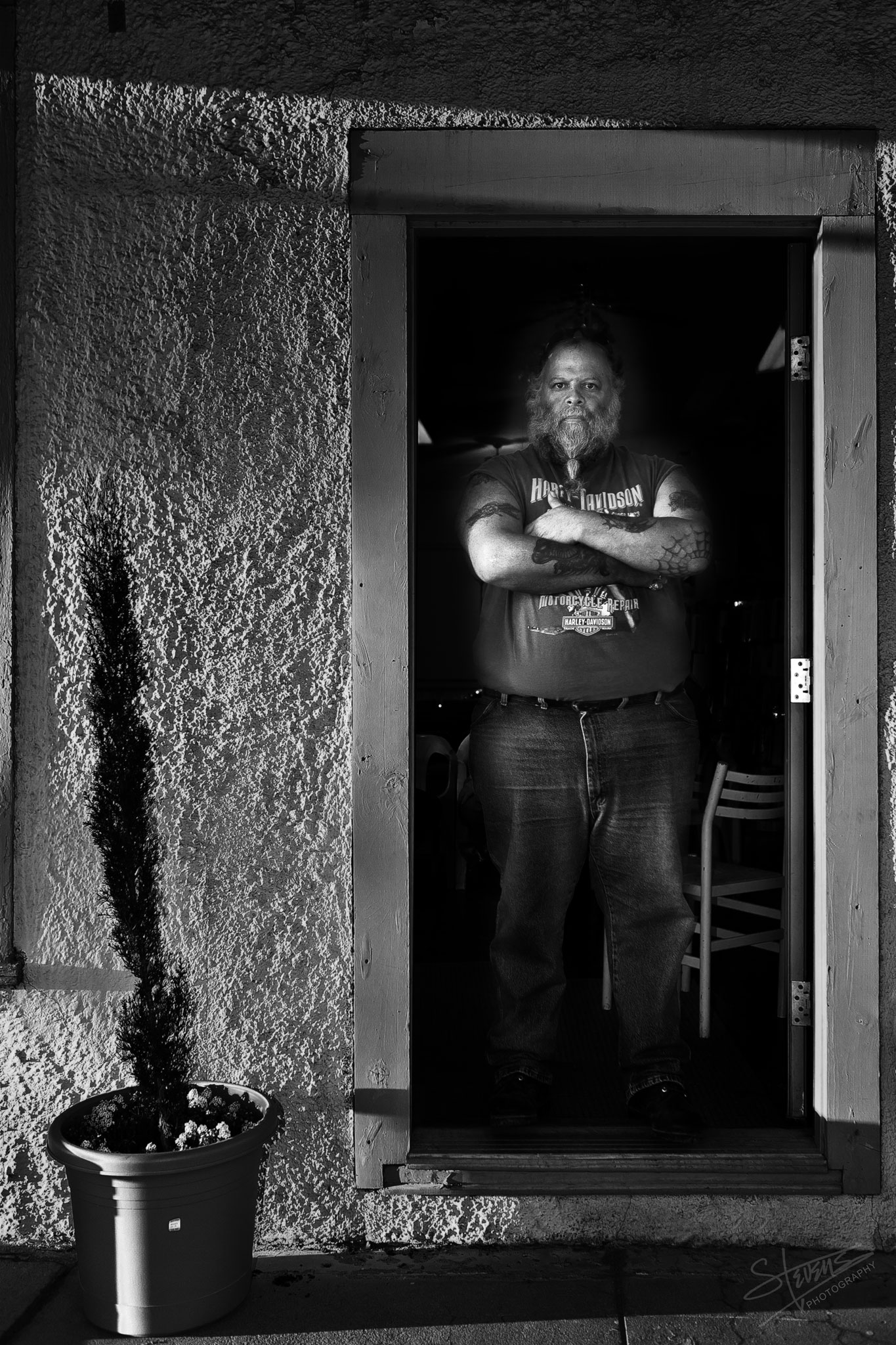Paul
At the Alpine, Texas Artwalk

It was early November, the first weekend if memory serves, and Alpine’s annual Artwalk was coasting toward its finale. The sun had dropped low enough to tint everything a gentle apricot; the breeze smelled like mesquite and kettle corn. I’d spent most of the day drifting from gallery to gallery, sipping cold brew at Front Street Books, losing track of the pocket-sized map they hand out at the visitor center. By late afternoon the sidewalks felt unhurried, as though everyone agreed the show was over but no one wanted to leave just yet.
That’s when a sliver of light caught my peripheral vision. A narrow bar on Holland Avenue — stucco the color of faded terra-cotta—was catching the last horizontal beam of the day. For maybe three minutes, a perfect rectangle of gold skimmed the doorway, painting rough plaster into hammered bronze. Next door, a pop-up gallery still blazed with white string lights, art patrons inside swirling plastic cups of pinot like fireflies in a jar.
I’m not the type who strikes up conversations with strangers just to make photographs. Most days I’d rather wait for a scene to arrange itself than ask someone to cooperate. But that fading light felt urgent, and the whole town seemed tuned to the same frequency — the unspoken agreement that art was the evening’s common language. So I overrode my normal caution and approached the one person who looked like he belonged in that doorway: Paul.
He leaned against a streetlamp, boots planted wide, felt hat tilted just enough to shade his eyes. Mid-thirties, maybe. His shirt — a Harley Davidson t-shirt with no sleeves — was a faded blue that seemed to complement the overall look. He wasn’t posing, but he carried the relaxed alertness of someone who could break a window or fix an engine with equal credibility. Even with a half-smile, there was something unmistakably unbudgeable about him.
“Mind if I borrow you for a photograph?” I asked, gesturing at the bar’s glowing doorframe.
He considered me half a second — long enough to decide I wasn’t selling anything — then shrugged. “Sure, man.”
We hustled to the threshold. I had shot the doorway empty before I approached him, locking in that sheet of gold before it fled. Then I had Paul step up. The light shifted another notch lower, sharpening every ridge in the stucco and filling his irises with liquid amber. I framed him to show his entire stature and gave a single direction:
“Look at me like there’s no way in hell I’m getting past you.”
A subtle flicker crossed his face — part amusement, part recognition — and just like that his features settled into a stare that could splinter plywood. It wasn’t anger. It was authority, elemental and natural, the same way a closed cattle gate on a ranch road says turn around without raising its voice. The line of his jaw locked, the shoulders squared an inch wider, and something in the set of his eyes said: Son, whatever you think you’re doing, you’d best think twice.
That was the moment I felt the weight of the stare. It wasn’t performance; it was a demonstration of potential. If he leaned forward, the world would lean back. If he cracked a grin, the tension would evaporate — sun on ice. Knowing he could toggle that switch at will made the intimidation more potent. Power unforced is the most persuasive kind.
Click. Shutter down.
In the next heartbeat the light collapsed — the rectangle shrinking, dimming, gone — like someone closing a stage curtain. Paul exhaled, chuckled, and dipped the brim of his hat. “Need anything else?”
“That was perfect,” I said, meaning it.
He nodded, said a quiet Take it easy, and walked east toward the gallery next door where his family had waited, melting into the purple dusk. I never caught his last name.
Back home in Dallas I reviewed the batch. One frame showed the doorway aglow but empty; the next froze Paul’s immovable gaze inside that same pillar of light. Separate, they were decent. Together, they felt inevitable. I layered the two digital frames —doorway and Paul — into a single composite. The stucco turned a deeper rust, his silhouette edged with gold, and those eyes, drilled straight through the glass, refused to let the viewer edge past. Converting the finished image to black and white felt less like a portrait and more like a caution sign: entry permitted, but only with permission.
When people ask how long the shot took, I say “about ninety seconds plus thirty years.” Ninety seconds for the light, the hurry, the single direction. Thirty years of learning to trust impulse when the universe tilts a mirror in your direction.
Alpine’s Artwalk has dozens of bright booths, but that evening the real exhibit was a man, a bar doorway, and sunlight so precise it could’ve been drawn by compass. I keep the print near my desk as quiet counsel: if a sliver of gold opens, step into it, ask the stranger, risk the stare.
And if someone looks at you like there’s no way in hell you’re getting by — believe them.
Please say hello. . . to Paul.
Have you ever had a moment of hesitation because you felt intimidated? I’d like to know.
— Lawrence

Thanks for reading Still Stories! Subscribe for free to receive new posts and support my work.

